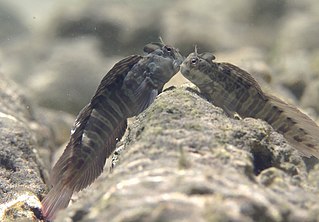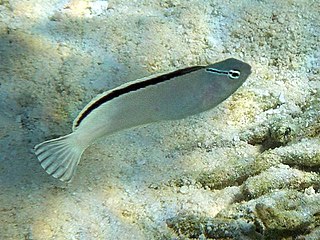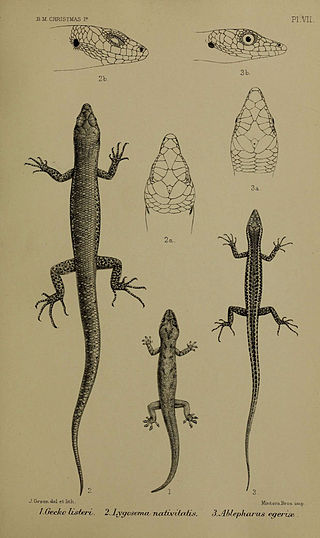
Combtooth blennies are blenniiformids; percomorph marine fish of the family Blenniidae, part of the order Blenniiformes. They are the largest family of blennies with around 401 known species in 58 genera. Combtooth blennies are found in tropical and subtropical waters in the Atlantic, Pacific and Indian Oceans; some species are also found in brackish and even freshwater environments.

The Christmas shearwater or ʻaoʻū is a medium-sized shearwater of the tropical Central Pacific. It is a poorly known species due to its remote nesting habits, and it has not been extensively studied at sea either.

Salarias fasciatus, commonly known as the jewelled blenny or lawnmower blenny is a benthic, neritic, marine fish species endemic to Australasia. Despite being known as the lawnmower blenny, due to its propensity to consume algae growth in aquaria, it is principally a detritivore, with plant material making up only about 15% of its diet. The lawnmower blenny camoflauges with its surroundings, even changing color to hide itself from predators.

Atrosalarias fuscus, also known as the dusky blenny, brown coral blenny or black blenny, is a species of marine fish in the family Blenniidae.

Meiacanthus atrodorsalis, the forktail blenny, is a species of combtooth blenny found in coral reefs in the western Pacific ocean. This species grows to a length of 11 centimetres (4.3 in) TL. This venomous species can also be found in the aquarium trade. It is also known as the eyelash harptail-blenny, poison-fang blenny or the yellowtail poison-fang blenny.

The Pacific leaping blenny, also known as the leaping rockskipper, is a species of combtooth blenny in the genus Alticus. The blennies are oviparous, and form distinct pairs when mating. Males can reach a maximum total length of 8 centimetres. These fish feed primarily on benthic algae, which they consume by scraping off rocky surfaces.

The East Indian lipsucker, Andamia heteroptera is a species of combtooth blenny found in the eastern Indian Ocean, around Christmas Island.

Istiblennius edentulus, the rippled rockskipper, is a species of combtooth blenny found in coral reefs in the Pacific and Indian Oceans. It is also commonly known as the rippled blenny, smooth-lipped blenny, toothless blenny, or coral blenny. Males of this species can reach a maximum of 16 cm (6.3 in) TL, while females can reach a maximum of 13.2 cm (5.2 in) SL.

Meiacanthus smithi, the disco blenny, is a species of combtooth blenny found in coral reefs in the eastern Indian Ocean. This species grows to a length of 8.5 centimetres (3.3 in) TL. It is also commonly known as Smith's fangblenny, Smith's sawtail blenny or Smith's harp-tail blenny. This species is also found in the aquarium trade.
Oman ypsilon, the Oman blenny, is a species of combtooth blenny found in the western Indian Ocean, around Oman. This fish reaches a length of 4 centimetres (1.6 in) TL. It is the only known species in the genus Oman.

Mimoblennius atrocinctus, the banded blenny, is a species of combtooth blenny found in the western Pacific and eastern Indian oceans. This species grows to a length of 5 centimetres (2.0 in) TL.

Omobranchus elongatus, also known as the cloister blenny or chevroned blenny, is a species of combtooth blenny found on coral reefs of the western Pacific and Indian Ocean.

Plagiotremus rhinorhynchos, commonly called the bluestriped fangblenny, is a species of combtooth blenny found in coral reefs in the Pacific and Indian Ocean. This species reaches a length of 12 centimetres (4.7 in) SL. It is also known as the bluestriped blenny, bluestriped sabretooth blenny, blunt-nose blenny, cleaner mimic, tube-worm blenny or the two-stripe blenny. They hide in deserted worm tubes or other small holes.
Praealticus natalis, the Christmas rockskipper, Natal blenny or the Natal rockskipper, is a species of combtooth blenny found in coral reefs around Christmas Island in the eastern Indian Ocean. This species grows to a length of 8 centimetres (3.1 in) TL.
Entomacrodus vermiculatus, the vermiculated blenny, is a species of combtooth blenny native to the Indian Ocean where it is found around the Seychelles, the Maldives and Christmas Island. It is largely an inhabitant of the intertidal zone where it is regularly exposed to the air which it is capable of breathing. This species reaches a length of 18 centimetres (7.1 in) TL.
Ecsenius oculus, known commonly in Micronesia as the ocular blenny and as the coral blenny on Christmas Island, is a species of combtooth blenny in the genus Ecsenius. It is found in coral reefs in the western Pacific ocean. It can reach a maximum length of 7 centimetres. Blennies in this species feed primarily off of plants, including benthic algae and weeds, and are commercial aquarium fish.

Xiphasia setifer, the hairtail blenny or the snake blenny, is a species of combtooth blenny found in the western Pacific and Indian Oceans. This species reaches 53 cm (21 in) in SL and is the longest species of combtooth blenny. It can also be found in the aquarium trade.
Emblemaria vitta, the ribbon blenny, is a species of chaenopsid blenny found around Navassa Island, in the western central Atlantic ocean. It is known to reach a length of 1.8 centimetres (0.71 in) SL.
Ceratobregma helenae, known commonly as the Helen's triplefin, is a species of triplefin blenny. It has an Indo-Pacific distribution from Christmas Island to Samoa, north to Taiwan and south to south eastern Australia. The species is named after Wouter Holleman's wife, Helen.

The Christmas Island forest skink, also known as the Christmas Island whiptail skink, is a species of skink formerly endemic to Australia's Christmas Island. As of 2017, it is listed as extinct on the IUCN Red List. The last known forest skink, a captive individual named Gump, died on 31 May 2014.















